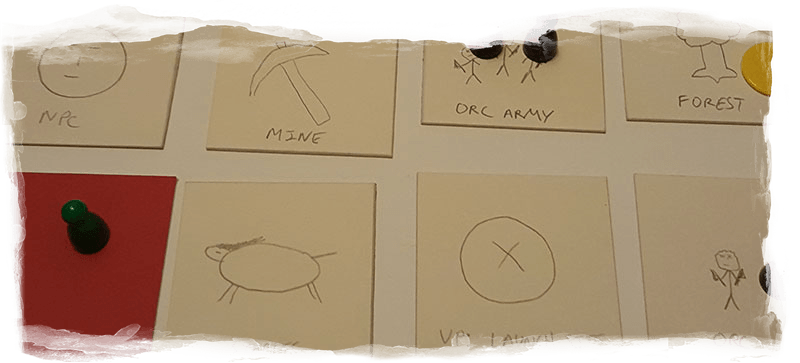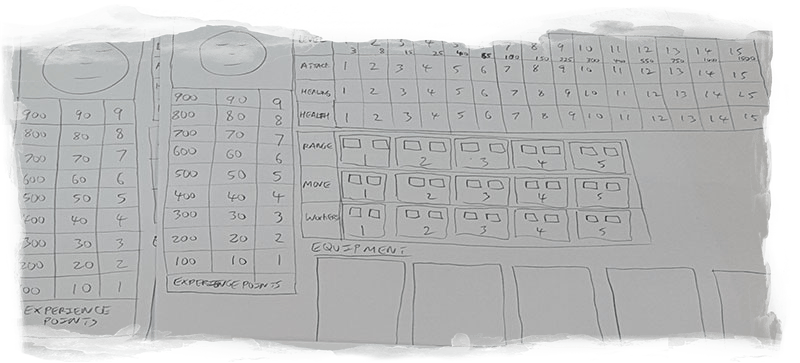Prototype development part 1
A few weeks ago I started developing the prototype for The City of Kings and thought it was about time I shared my progress.
I think one of the hardest things with making a large game is knowing where to start. I have a good idea of how the game should work but turning it into a physical, playable game is not so easy.
At first I spent many hours worrying about the map, how combat should work, how stats would be balanced, what items were needed and what quests should involve. I found myself going round in circles, it seemed impossible to do one thing without already having the other in place.
GETTING STARTED
My plan was simple, get everything ready so the building could begin uninterrupted.
- I cut out 100+ map tiles.
- I purchased 100’s of different coloured tokens.
- I purchased a variety of coloured pawns.
- I purchased 1000 blank cards.
- I purchased 20 blank dice.
- I purchased some pencils, rubbers and a pencil sharpener.

The goal was to make sure I had everything I could need and much more, I wanted to create an environment where needing another piece wouldn’t interrupt the building and testing process.
I also set a clear rule that artwork, text and sizes wouldn’t impact decisions at this point. I can iterate over card design later, right now I just needed to understand how the game would play.
CREATING THE MAP
Stage 2 was to design the basic map, I already had an idea of the kind of things I wanted so I started drawing on tiles creating a playable world. With plenty of spare tiles it wouldn’t matter if things needed to be swapped out during playtests.

As soon as the tiles were complete I found myself panicking:
- There are too many NPCs.
- It is lacking variety.
- Should creatures be handled this way?
- It was too big and would take forever to play but reducing the size would make the game less interesting.
I was stuck.
PLAYTESTING
My instinct was to start drawing new tiles and start again, but before doing so I wondered, why not just try it?
I shuffled the tiles and placed them face down on the table. I placed two pawns on the starting square and proceeded to play with Sara. We moved around the board following the basic rules that had been set out and tried to simulate the gameplay where possible.

Surprisingly things seemed to work out OK, we repeated this a couple of times and the map held its ground. This was a valuable lesson, just getting to a point where you can play something as quickly as possible is critical. It is easy to be overly positive about an idea and even easier to doubt yourself so you just have to try it out.
NEXT STEPS
An added bonus of testing the map was identifying what needs to come next. The rules around movement in TCoK are strongly controlled by your player card and this was the next logical thing to create.

This allows us to keep track of each player’s stats and equipment during a game so we’re ready to start creating a few basic items and seeing how the numbers balance.
Whilst moving around the map we also identified how long combat should last and given the basic player stats we should have a rough idea of how strong our early enemies should be.
It’s starting to feel like we’ve entered a natural flow for the prototype development and I hope to create much more in the coming weeks. Each new feature will be followed by some basic playtests which in return helps to define the next thing we need to build.
Frank West
Frank West is a gamer and designer based in Bristol, UK. He published his first board game, The City of Kings, in 2018 and now works on other games and organising events in the local area. His goal? To design and publish games focusing on immersive themes, fun mechanics and beautiful components. If you have any questions or would just like a chat, feel free to get in touch at any time!


2 comments
Chris Long
10th September 2025 at 7:12 am
Hi Frank, really good articles. I’m at the start, found myself at the start almost by accident after putting a game together quickly in April. But I’m going down a very specific auteur publishing house route, so literally everything is done by me, including all hand (analogue) produced artwork. Biggest lesson so far? This is a lot to do by a single person, as well as work in a full tie job, and my initial launch plans went out of the window quite quickly. It’s still early days for me but the advice on it’s never too late to delay, yes.
Keep up the good work!
Chris
Frank West
11th September 2025 at 2:49 pm
Thanks Chris, I’m glad you’ve been enjoying them.
I wish you all the best on your own journey, there is a lot to learn early on and everything takes longer than you’d expect. But it is a fantastic journey and one that I hope you will enjoy!